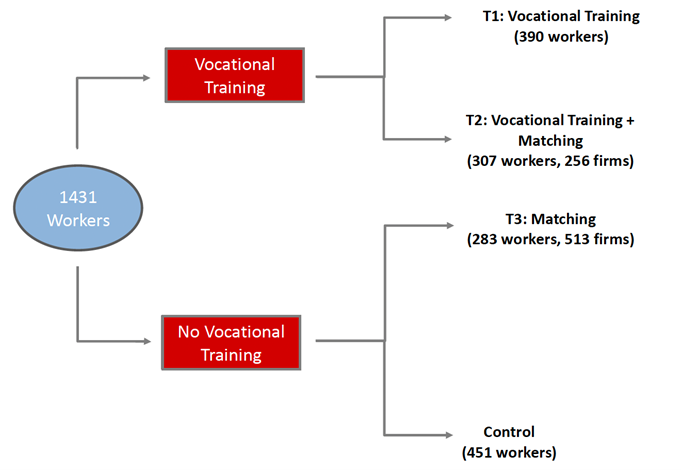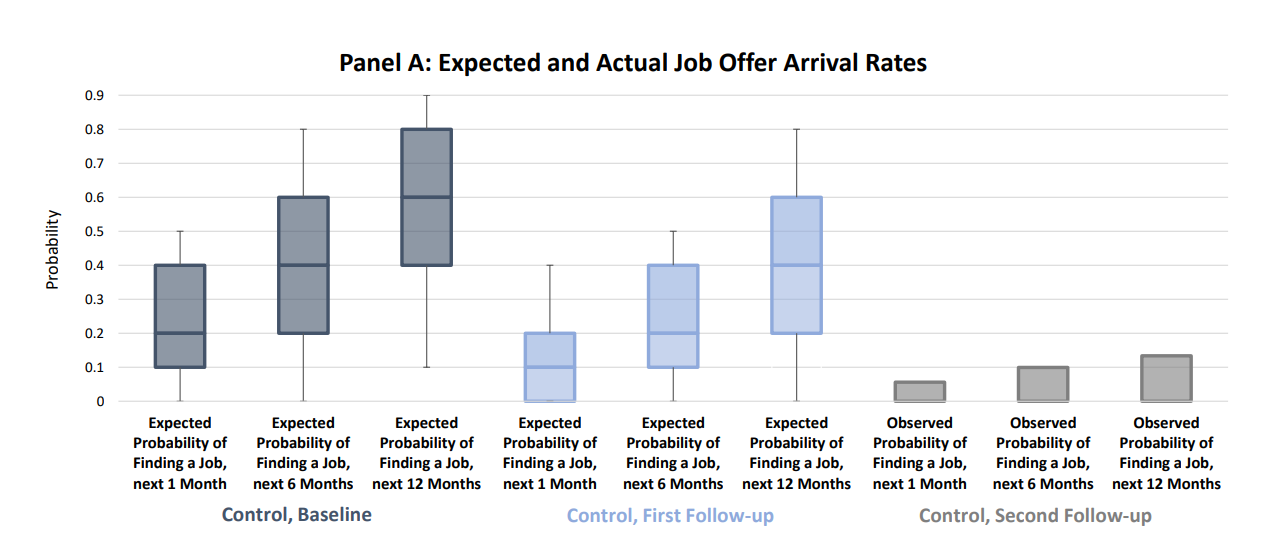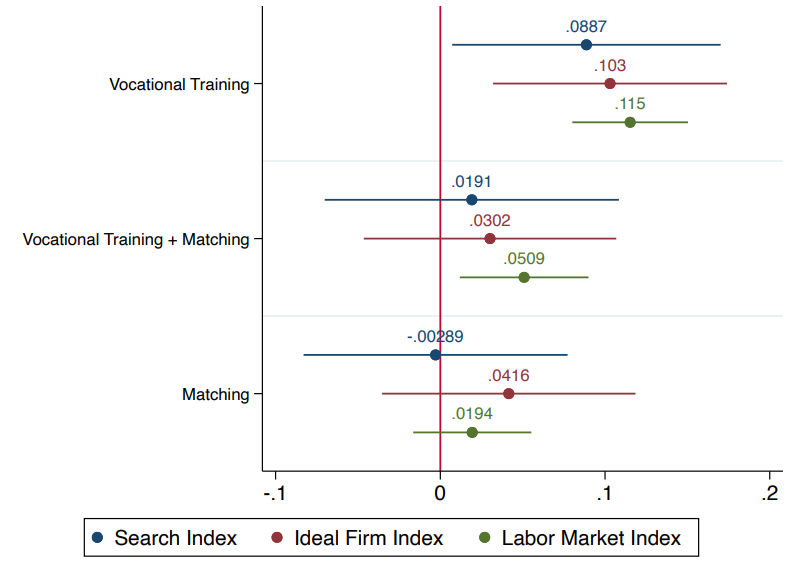To design policies that lead young labour-market entrants to good jobs, it is important to understand job search processes and what affects the ability to find gainful employment. Based on an experiment in Uganda involving two interventions – vocational training and matching workers with firms – this article shows that while training enhances optimism about employment prospects, matching causes discouragement and poorer labour market outcomes in the long run.
In the developing world, high fertility rates and limited job creation make access to quality employment increasingly challenging for young labour market entrants (Bandiera et al. 2022, International Labour Organization, 2023). The central question that confronts policymakers and researchers in this scenario is how to design policies that lay the groundwork for long-term success by placing workers onto trajectories leading to good, formal jobs. Understanding how youth search for jobs and what affects their ability to find gainful employment is paramount to achieve this objective.
Our study (Bandiera et al. 2023) addresses this question through a field experiment tracking young labour-market entrants in Uganda over six years, and examining the link between skills, expectations, search behaviours and long-run labour market outcomes. It explores this link using experimental variation in workers’ exposure to two standard labour market interventions: vocational training and matching between workers and firms (Card et al. 2017, McKenzie 2017, Carranza and McKenzie 2023). This article summarises the results from the experiment, shedding light on the impact of these interventions on job search and labour market outcomes, with a focus on the role of expectations in mediating these effects.
Interventions
In partnership with the NGO BRAC, in 2012 we recruited 1,400 labour-market entrants from across Uganda to participate in the study. We targeted economically disadvantaged youth, who at baseline were either unemployed (60%) or reliant on insecure, informal jobs (30%). Workers applied to receive vocational training in welding, motor mechanics, electrical wiring, construction, plumbing, hairdressing, tailoring, or catering. These sectors are associated with ‘good jobs’ providing regular employment in high-wage firms.
Workers were randomised into three ‘treatment’ (intervention) groups: (i) vocational training; (ii) vocational training combined with a light-touch matching intervention that passes workers’ details to firms; and (iii) matching only. This was done through a two-step procedure, as outlined in Figure 1. Individuals were first randomly assigned to receive an offer of vocational training. This consisted of a six-month sector-specific and classroom-based training programme delivered by reputable vocational training institutes. In an earlier study, we show that this type of training is highly effective at providing workers with valuable skills (Alfonsi et al. 2020). At the second stage, we offered light-touch matching between workers and firms. Worker-firm matches were restricted to take place between firms in the same sector as the worker had been trained in, or had desired to be trained in, and within the same region. Eligible firms were identified through a census of small and medium enterprises. Firms were presented with the CVs of a maximum of two workers that were either both vocationally trained (T2 in Figure 1), or both unskilled but willing to work (T3 in Figure 1). They could decide to call back for an interview neither, one, or both workers.
We tracked workers through four follow-up surveys conducted at 24, 36, 48, and 68 months after baseline (corresponding to 12, 24, 36, and 56 months following the conclusion of the interventions). This allowed us – perhaps uniquely – to track a cohort of labour-market entrants over six years, linking short-term changes in expectations and job search behaviour induced by the interventions to long-run impacts on labour market outcomes.
Figure 1. Experimental design


Note: The numbers in parentheses refer to the number of eligible applicants originally assigned to each treatment, and the number of firms assigned to each treatment.
Evolution of expectations and reaction to call-backs
Using data from the ‘control’ group (those who did not receive any intervention) over time, we document that although workers have relatively accurate beliefs over the earnings distribution in the study sectors, they are optimistic about the probability of receiving a job offer in these sectors: their expected probability of employment remains much higher than actual job finding rates throughout the study period, although workers gradually become more realistic (Figure 2).
Figure 2. Expected and actual probability of receiving an offer among control group

Note: The first and second follow-up surveys were conducted 24 and 36 months after baseline, respectively (that is, 12 and 24 months after the end of the training and matching interventions).
The key outcome for workers in the matching intervention is whether firms call them back for an interview. Tracking the evolution of beliefs from baseline to the eve of match offers being announced, we see that trainees become ever more optimistic about their job prospects, while those randomised out of training gradually revise down their beliefs. The match offer intervention is then implemented among these groups of increasingly optimistic youth offered vocational training, and increasingly realistic youth randomised out of vocational training.
Among trainees, the actual call-back rate is far lower than their expectations: only 16% receive a call-back (compared to an expected 30% call-back rate). Among those randomised out of training, call-back rates are in line with prior expectations (18% and 20% respectively). Importantly, call-backs are uniquely determined by vacancies and other firm characteristics, and do not depend on worker characteristics. However, workers were not told the reasons for lack of call-backs, and even though vocational trainees were matched to only a few firms, the matching intervention was perceived to be a highly salient opportunity to find work since it was implemented by a reputable NGO. Therefore, the lower-than-expected call back-rate among vocational trainees might generate bad news and cause them to revise down their expectations about their own job prospects. For workers randomised out of training, the rate of call-backs is already in line with their beliefs.
Impact on workers’ search behaviour and long-run labour market outcomes
Our first set of results document how these interventions impact worker expectations and job search behaviour after a year.
Compared to workers in the control group, vocational trainees revise upwards their expectations over the probability of receiving a job offer in one of the study sectors, as well as their expected earnings, thus becoming increasingly optimistic. As a result, they search more intensively relative to the control group and direct their search towards higher quality firms.
Relative to those only offered training, vocational trainees also offered matching hold lower expectations over the probability of receiving a job offer and the distribution of earnings in good sectors. This is consistent with discouragement effects due to the lower-than-expected call-back rate. Such discouragement is reflected in their search behaviour: relative to those only offered vocational training, those additionally offered matching search less intensively, and over lower quality firms.
Workers only offered matching – relative to the control group – do not adjust their expectations or search behaviour on most margins, as their call-back rate is in line with their prior expectations. However, they are significantly more likely to start borrowing to finance self-employment activities in the year following the intervention.
Our second batch of results look at long-term changes in labour market outcomes. Through the follow up surveys after 24, 36, and 56 months, we examine whether the interventions lead to differences in long-term labour market outcomes two to six years later. We find that relative to the control group, those offered vocational training (with or without matching) are more likely to be employed, to transition into regular work, to be employed in good sectors, and end up in better jobs. However, contrasting vocational trainees with and without the additional offer of matching, we find those with match offers do significantly worse on labour market outcomes up to six years later: they are less likely to work in regular jobs, and work less time in one of the eight good study sectors. Relative to those only offered vocational training, they also end up sorting to lower quality firms and lower quality jobs and have lower earnings.
To quantify these long-run differences, we construct an index of overall labour market success combining information on various measures of both employment and earnings. This index significantly increases for those offered vocational training relative to those in the control group (Figure 3). For those additionally offered matching, the index increases by less than half: because the lower-than-expected match offers to vocational trainees cause youth to become discouraged, they undo half of what is achieved through vocational training alone.
Workers only offered matching are significantly more likely to enter self-employment. However, on this overall labour market index we find, in line with earlier meta-analyses (Card et al. 2017, Carranza and McKenzie 2023), that matching alone does not lead to better outcomes relative to controls.
Figure 3. Impacts of the intervention on search intensity and direction and labour market outcomes
Policy implications
The results from this study highlight the foundational role that expectations play in determining workers’ job search and long-term labour market outcomes. They show how young job-seekers can misconstrue information provided to assist them through job search, leading to persistent ‘scarring’ effects that arise from changes in beliefs and impacting subsequent job search behaviour. These results emphasise that interventions aiming to provide (useful) information to workers about the labour market or aspects of job search need to be carefully considered – both in terms of their framing, and their timing. There are three lessons that can be learnt from this study on how to design these types of labour market policies:
First, the framing of job placement interventions can be a key determinant of whether workers end up misattributing information about aggregate labour demand conditions as being informative of the returns to their own ability. A review of the existing evidence suggests that in job fairs or job assistance interventions that provide aggregate information, it is clear that signals conveyed to workers are relatively more informative of the market as a whole, rather than individual job prospects (Abebe et al. 2020, Kelley et al. 2022, Chakravorty et al. 2023). Such interventions can reduce overoptimism without discouraging workers. On the other hand, job assistance interventions that tailor feedback to the specific individual (Altmann et al. 2018, Belot et al. 2019) create more scope for workers to misattribute signals as being informative of their own labour market prospects and lead to discouragement.
Second, the timing of job placement offers is likely to affect the salience of the signal. In our study, match offers are implemented as workers graduate from training, which is the time when trainees are most optimistic about their prospects. If match offers had been implemented after trained workers had searched for jobs by themselves for some time, their likelihood to discourage workers might have differed.
Finally, our results indicate that relying on vocational institutes to secure jobs for their trainees might not sufficient to enhance their employability.. Coupled with emerging evidence of severe information frictions faced by vocational training institutes in securing employment for their graduates (Banerjee and Chiplunkar 2023), our findings suggest that effective job matching might be beyond the scope of vocational training institutes without substantial resources dedicated to understanding and adapting to the ever-changing labour market.
Our data highlight two challenges. First, our job matching intervention resulted in only a handful of hires, due to a shift in demand from when firms were initially surveyed to when vocational training is completed. Firms that reported hiring constraints at baseline no longer required workers by the end of the training period. Second, there are subtle behavioural biases to which workers are subject that can lead to job placement efforts backfiring. This highlights that effective matching is not just about connecting individuals to firms, but it requires constant updating and a deep understanding of both demand and supply conditions, as well as workers’ behavioural responses to information.
Further Reading
- Abebe, G, et al. (2020), ‘Job Fairs: Matching Firms and Workers in a Field Experiment in Ethiopia’, Working Paper. A version of this paper is available here.
- Alfonsi, Livia, et al. (2020) “Tackling Youth Unemployment: Evidence from a Labor Market Experiment in Uganda”, Econometrica, 88: 2369-3414.
- Bandiera, Oriana, Ahmed Elsayed, Andrea Smurra and Celine Zipfel (2022), “Young Adults and Labor Markets in Africa”, Journal of Economic Perspectives, 36(1): 81-100.
- Bandiera, Oriana, Vittorio Bassi, Robin Burgess, Imran Rasul, Munshi Sulaiman and Anna Vitali (2023), “The Search for Good Jobs: Evidence from a Six-year Field Experiment in Uganda”, Journal of Labor Economics, forthcoming.
- Banerjee, AV and G Chiplunkar (2023), ‘How Important are Matching Frictions in the Labor Market? Experimental and Non-experimental Evidence from a Large Indian Firm’, Working Paper. Available here.
- Banerjee, Abhijit V and Sandra Sequeira (2022), “Spatial Mismatches and Imperfect Information in the Job Search”, Journal of Development Economics, forthcoming.
- Belot, Michele, Philipp Kircher and Paul Mullera (2019), “Providing Advice to Jobseekers at Low Cost: An Experimental Study on Online Advice”, Review of Economic Studies, 86(4): 1411-1447.
- Card, David, Jochen Kluve and Andrea Weber (2017), “What Works? A Meta Analysis of Recent Active Labor Market Program Evaluations”, Journal of the European Economic Association, 16(3): 894-931.
- Carranza, Eliana, Robert Garlick, Kate Orkin and Neil Rankin (2022), “Job Search and Hiring with Limited Information about Workseekers’ Skills”, American Economic Review, 112(11): 3547-85.
- Carranza, E and D McKenzie (2023), ‘Job Training and Job Search Assistance Policies in Developing Countries’, World Bank Policy Research Working Paper 10576.
- Chakravorty, B, W Arulampalam, AY Bhatiya, C Imbert and R Rathelot (2023), ‘Can Information About Jobs Improve the Effectiveness of Vocational Training? Experimental Evidence from India’, Working Paper. A version of this paper is available here.
- Kelley, EM, C Ksoll and J Magruder (2022), ‘How do Online Job Portals affect Employment and Job Search? Evidence from India’, Working Paper.
- International Labour Organization (2023), ‘World Employment and Social Outlook: Trends 2023’, Executive Summary.




 24 April, 2024
24 April, 2024 










Comments will be held for moderation. Your contact information will not be made public.